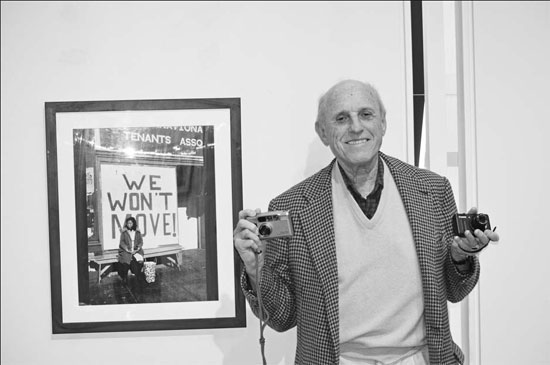Forty years of Chinatown from the hip
Updated: 2013-02-01 12:05
By Chen Jia in San Francisco (China Daily)
|
||||||||
|
Maurice Edelstein is a 82-year-old photographer whose works focus on the first generation of Chinese immigrants and their offspring. Chen Jia / China Daily |
Photographer exhibits images of historic area in San Francisco
Maurice Edelstein, an 82-year-old photographer and native of California, says he has never been to Hong Kong, though the next best thing in his heart is San Francisco's Chinatown.
"For a photo nut like me, this is paradise. It is Hong Kong West," Edelstein said at the Chinese Culture Center of San Francisco, which is exhibiting his Images from Chinatown collection between Jan 13 and Feb 2.
For the last half century, he has been walking this historic neighborhood, taking "zillions of pictures" and capturing the area's rich, colorful environment.
Though San Francisco, in recent years, has had many new immigrants from China, Edelstein's works focus on the first generation of Chinese immigrants and their offspring.
"I think the reason I'm drawn there is that I see a great similarity between these early immigrants who speak little or no English with my Jewish family who arrived in New York in the early days of the last century and settled in the Lower East Side of New York and spoke only Yiddish," he said. "Both groups had and have similar problems of discrimination, the struggle to make a living and to educate their children."
In the exhibition, there are historical photos of Chinatown, especially of the protest at I-Hotel during the late 1960s that depicts the neighborhood's activism history and vibrancy.
His retrospective solo exhibition also examines the lives of residents framed by everyday street backdrops. His photography spotlights the people who live and work within Chinatown, one of the densest neighborhoods in the country.
Forty years ago, Edelstein bought what was called a "spy" camera, a Minox. It fitted on his belt and had a side-view finder, which allowed him to get up close and take candid shots of subjects without revealing to the subject that he or she was being photographed.
Later he graduated to three Minox cameras, one for color, and the others in black and white with different film speeds to suit the occasion. It became a habit for him to walk with one of the cameras in his hand and another on his belt looking for his "perfect shot".
When he found that the negatives on the Minox were too grainy for artistic enlargements, he began to use small single lens reflex cameras that were small enough to fit in a suit pocket.
"I had become adept at shooting from the hip, not looking at the 'target,' so people in Chinatown have natural facial expressions before my camera lens," he said.
But Edelstein, who doesn't speak Cantonese or Mandarin, can't fill in all the details to every story behind his photos because he can't communicate with his subjects.
He is encouraging his grandson to study Chinese, in the hopes that the skill will help him in his job hunt in the future.
"He has started to study Mandarin from his first grade and visited China several times on for summer camps of culture study," he said.
Works by Edelstein, who has been dubbed a "dear friend" by the local Chinese community, were documented and exhibited at the Chinese Culture Center in 1998 and 2004.
He had his first solo exhibit at the Chinese Culture Center - it ran for 10 weeks in 1998. Gary and Christina Tan, who had just opened a restaurant called The Dragon Well (located on Chestnut Street), asked if they could display his pictures at their new restaurant after visiting the exhibit that year.
"Thanks to the exposure at the Dragon Well, many of my pictures are now in the permanent collection at the Chinese Historical Society in the City," he said.
Images from Chinatown is the first exhibition of Episode, the new exhibition series launched by the Chinese Culture Foundation this year.
Episode features guest curators, collectors, artists and community organizers as well as a broad scope of diverse works in Chinese culture and art. The Chinese Culture Foundation was founded in 1965 and aims to promote and influence the courses of art and culture. The Chinese Culture Center opened in 1973 as the foundation's primary program site.
chenjia@chinadailyusa.com

 In Photos: 7.0-magnitude quake hits Sichuan
In Photos: 7.0-magnitude quake hits Sichuan
 Li Na on Time cover, makes influential 100 list
Li Na on Time cover, makes influential 100 list
 FBI releases photos of 2 Boston bombings suspects
FBI releases photos of 2 Boston bombings suspects
 World's wackiest hairstyles
World's wackiest hairstyles
 Sandstorms strike Northwest China
Sandstorms strike Northwest China
 Never-seen photos of Madonna on display
Never-seen photos of Madonna on display
 H7N9 outbreak linked to waterfowl migration
H7N9 outbreak linked to waterfowl migration
 Dozens feared dead in Texas plant blast
Dozens feared dead in Texas plant blast
Most Viewed
Editor's Picks

|

|

|

|

|

|
Today's Top News
Live report: 7.0-magnitude quake hits Sichuan, heavy casualties feared
Boston suspect cornered on boat
Cross-talk artist helps to spread the word
'Green' awareness levels drop in Beijing
Palace Museum spruces up
First couple on Time's list of most influential
H7N9 flu transmission studied
Trading channels 'need to broaden'
US Weekly

|

|








